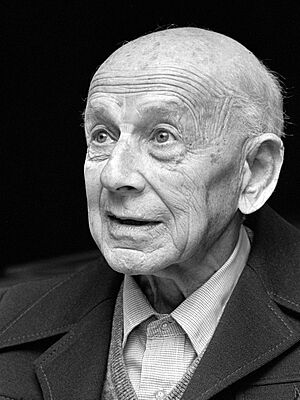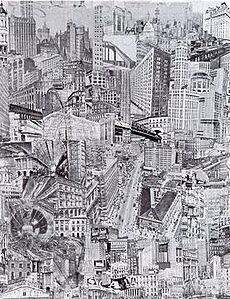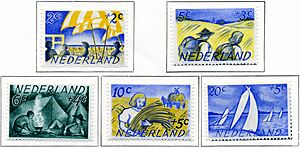Paul Citroen facts for kids
Quick facts for kids
Paul Citroen
|
|
|---|---|

Citroen in 1981
|
|
| Born | 15 December 1896 |
| Died | 13 March 1983 (aged 86) |
| Nationality | Dutch |
|
Notable work
|
Metropolis, postage stamps |
Roelof Paul Citroen (born December 15, 1896 – died March 13, 1983) was an artist and teacher. He was born in Germany but became Dutch. Paul Citroen also helped start the New Art Academy in Amsterdam. Two of his most famous works are the photo-montage called Metropolis and the Dutch postage stamps he designed in 1949.
Contents
About Paul Citroen
His Early Life and Art
Paul Citroen grew up in Berlin, Germany. His father was Dutch and his mother was German. Both of his parents were Jewish. Paul started drawing when he was very young. His parents really supported his artistic talent. He also began to try out photography with a friend named Erwin Blumenfeld.
Paul Citroen was part of an art movement called Dadaism. Dadaism was a style of art that challenged traditional ideas. He also used the Bauhaus Style in his photography. This style often showed people looking straight into the camera.
In 1919, Paul Citroen went to study at the famous Bauhaus art school. There, he learned from well-known artists like Paul Klee and Wassily Kandinsky. Around this time, he started working on his most famous piece, Metropolis (1923). This artwork is a photo-montage, which means it's made by combining different photographs. Metropolis is kept at Leiden University Libraries. It even inspired the classic film Metropolis by Fritz Lang. From 1929 to 1935, Citroen took many photographs, showing how much he learned from working with Erwin Blumenfeld. His art was also shown in a big exhibition in Amsterdam in 1939.
His Later Life and Teaching
Later, Paul Citroen opened a new art school called the Nieuwe Kunstschool with Charles Roelofsz. However, the school had to close in 1937 because it ran out of money. That same year, Citroen became a teacher at the Royal Academy of Art in The Hague.
During World War II, it became dangerous for Jewish people in Europe. Paul Citroen had to go into hiding in 1942 to stay safe. He was hidden by a German woman named Maria Helena Friedlaender in her attic for several months.
Paul Citroen taught many students who later became artists themselves. In 1949, he designed some important postage stamps for the Netherlands. He stopped teaching in 1960 and focused mainly on painting portraits. He painted many famous Dutch people, including a well-known portrait of the singer Liesbeth List in 1979.
Paul Citroen passed away in 1983 in Wassenaar, Netherlands.
Where to See His Art
You can find Paul Citroen's artworks in many public collections around the world, including:
- Gemeentemuseum Den Haag
- Hermann-Hesse-Museum, Calw
- Literatuurmuseum, The Hague
- Museum De Fundatie, Zwolle
- Rijksmuseum Amsterdam
- Leiden University Libraries Prentenkabinet
- Stedelijk Museum Amsterdam
- MoMA, New York
- Metropolitan Museum of Art, New York
- Art Institute of Chicago
See also
 In Spanish: Paul Citroen para niños
In Spanish: Paul Citroen para niños



